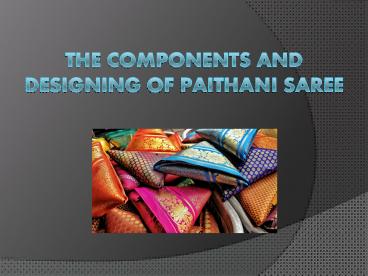THE COMPONENTS AND DESIGNING OF PAITHANI SAREE
Title:
THE COMPONENTS AND DESIGNING OF PAITHANI SAREE
Description:
OnlyPaithani is store for handloom silk sarees, a beautiful saree which is handwoven in pure silk and zari with traditional border and a grand pallu. An initiative to promote this beautiful art and our rich tradition. For more visit: – PowerPoint PPT presentation
Number of Views:232
Title: THE COMPONENTS AND DESIGNING OF PAITHANI SAREE
1
THE COMPONENTS AND DESIGNING OF PAITHANI SAREE
2
History
- India is well understood since early times for
its own handloom and fabric quilting industry.
Some of the significant commerce items while in
the Indo-Roman commerce from the next century CE
have been woven cloth, notably muslin, a material
which may be embroidered and dyed, coming from
Paithan. - The Paithani, a pure handloom silk sarees having
a zari of silver and silver traces its source
into the brocades of this Yadavas that were
sourced out of Paithan. - Some descriptions of those brocades are tracked
for example Ganga varni (from the colors of this
Ganga), Bora prison (brocades with sprigs of
flowers) and also Malganthi, also a textured
cloth found at the Yadava Empire.
3
The Components
- The Paithani is dependent upon its own feature
Kath and padar that have common themes. These
themes are still a significant part pinpointing
the Paithani. Several forms and forms of these
subjects exist. - The Padar (Pallu)
- The Paithani padar includes its very own distinct
design. It generally is composed of themes of
peacocks, blossoms, and foliage. - The padar is usually approximately 24 to 36
inches of woven zari work on the same end of this
saree and hangs loose within the left shoulder
when the saree is draped. - The Entire burden of some completed Paithani
varies from 900 gm into 1500 gm based on the
caliber of silk and zari used in addition to
quality, width, and labor demanded around the
Kath and Padar.
4
- The Aanga (Body)
- The plain or stained fabric that's the
significant part of the saree is stitched lace
using small buttis. Even the buttis are maybe of
changing layouts. The entire span of the saree
could be'sahavari' or 'nauvari' using a 'var'
being comparable to some yard of fabric. - The standard Paithani is so both yards or two
yards in total and the diameter involving the
zari is just one Panna or 44-inches. - The Kath (Edge)
- The edge of this saree is at zari to add
stiffness to the fabric and guard its borders
from tear and wear. That can be called Kath. The
Kath is decorated with traditional themes and
changes in depth from 2 inches to one foot
predicated on the art of the weaver and design
chosen to its saree. Kath is combined the borders
of your human body of this saree and was created.
5
Designing Techniques
- The term designing' describes this complete
handloom cotton silk saree designing isn't just a
brand new idea. The idea exists in pre historic
cave paintings according to layouts appearing
costumes, tapestries, and rugs, etc... . - Before Weaving
- The attributes of these fibers deserve
Consideration, since it's the fiber by the
programmer begins. - Various fibers have various feasibilities and
limits. Jute is naturally rigid, however. - Silk is soft and fine and also the ways when the
fibers have been processed to yarns signify the
typical qualities of the fabrics and indicate
chances for underlying structural design and
style and also for employed ornamentation.
6
- Throughout Weaving
- The next thing is the way in that the fibers are
interlaced to make a cloth. The embellishment
originates from the arrangement of these fabrics.
It's usually known as a structural layout. - These layouts might arise once the yarns are
increasingly being siphoned. The various weaves
used will create various layouts. - Post Weaving
- The 3rd manner consists of many Ways of
ornamenting textiles. In this, the layouts could
be introduced into fabrics with the Assistance of
Embroidery, appliqué printing and printing.
Ordinarily, elevated layouts are created when we
Utilize needle along with other fastening devices.
In today's world, the combination of historical
culture and modern design Paithani sarees are
available for bridal saree online shopping too.
There are platforms like OnlyPaithani, providing
you the original richness and authenticity of
handloom sarees at your doorstep.
7
Thank You

